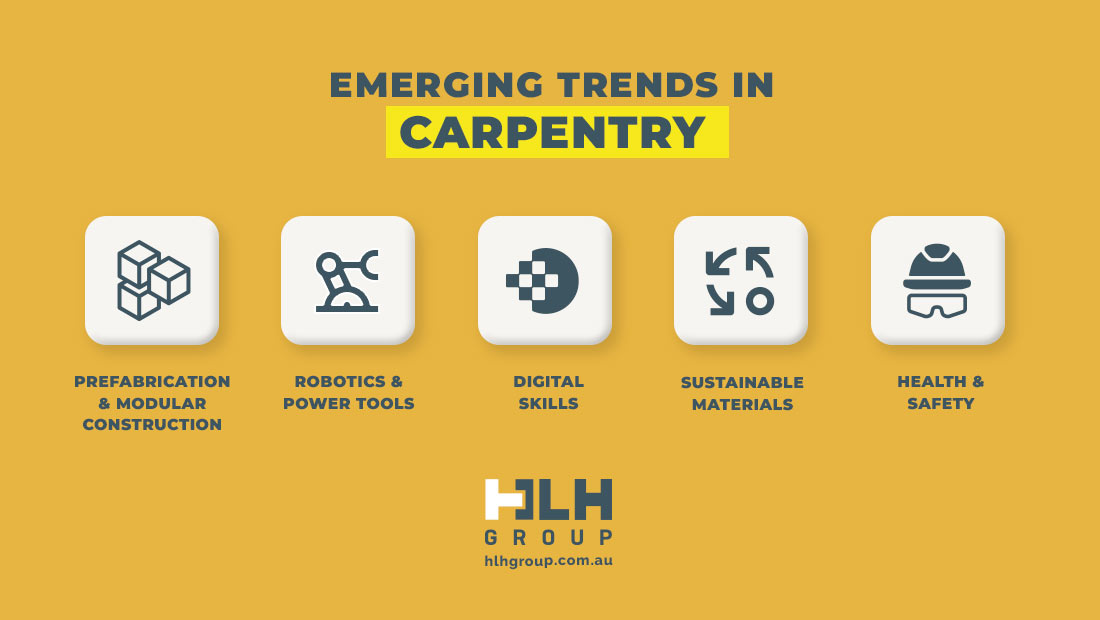
31 Oct Future Proofing Carpenters – Emerging Skills, Materials & Careers
Carpentry is evolving fast. New building methods such as prefabrication and modular construction, robotics on the job site and a surge in sustainable materials are reshaping what it means to be a carpenter. This article looks at the trends driving change and how carpenters can adapt. Off‑site manufacturing and robotics are automating repetitive tasks, while smart‑building technologies and digital tools require new skill sets. Sustainable materials like cross‑laminated timber (CLT) are gaining popularity, offering carpenters opportunities to work on low‑carbon projects. We’ll outline the training, certifications and career pathways carpenters should pursue to stay competitive.

Emerging Trends in Carpentry
- Prefabrication and Modular Construction: Automated manufacturing facilities produce wall panels, floor cassettes and modular units off‑site. Carpenters increasingly work in factory settings assembling components or on site installing prefabricated elements. Learning to interpret factory drawings and use lifting equipment is essential.
- Robotics and Power Tools: Robots and cobots (collaborative robots) assist with repetitive or hazardous tasks such as cutting, drilling and transporting materials. Carpenters should become comfortable working alongside automation and focus on tasks requiring human judgement, craftsmanship and problem‑solving.
- Digital Skills: BIM and AR/VR tools allow carpenters to visualise projects before work begins. Knowing how to read digital plans, use AR‑enabled devices to overlay measurements and update progress in real‑time will become standard practice. Online project management platforms also streamline communication with site supervisors and other trades.
- Sustainable Materials: Demand for eco‑friendly timber products is rising. Cross‑laminated timber (CLT) and laminated veneer lumber (LVL) offer high strength and lower embodied carbon than steel or concrete. Carpenters who learn to work with these materials and understand their fastening systems will be in high demand as green buildings grow in popularity.
- Health and Safety: With automation and off‑site fabrication, traditional hazards change. Carpentry remains a physically demanding trade, but new risks include interacting with robots, lifting prefabricated modules and working in high‑tech factories. Staying up‑to‑date with safety guidelines and personal protective equipment is vital.
Carpentry Career Pathways and Training
- Upskill in Technology: Take short courses in BIM, AR/VR visualisation or digital tools used in construction. Becoming proficient with tablets and software will make you more employable.
- Learn Prefabrication Techniques: Many TAFE colleges and trade schools now offer modules on modular building and off‑site fabrication. Seek training in factory‑assembly processes and installation methods.
- Specialise in Sustainable Building: Courses on CLT installation, passive‑house construction and green‑star requirements can open doors to high‑profile eco‑projects.
- Leadership and Project Management: Experienced carpenters can progress to site supervisor, foreman or project manager roles. Studying project management will help you coordinate teams using digital tools and advanced construction methods.

Frequently Asked Questions About Carpenters
Q: Will robots replace carpenters? Robots can handle repetitive or heavy tasks, but they still need human oversight. Carpentry involves creativity, problem‑solving and finishing skills that machines cannot replicate. Embrace automation as a tool to improve safety and productivity rather than a threat.
Q: What Certifications Do I Need for Prefabrication? In addition to a carpentry trade qualification, consider certificates in prefabricated building installation or construction management. Some manufacturers offer proprietary training on installing their systems.
Q: Are Sustainable Materials Harder to Work With? Green timber products like CLT require different fastening techniques and attention to moisture control, but most experienced carpenters adapt quickly with the right training. Working with these materials can expand your job opportunities as green construction grows.

Future Proofing Carpentry
Carpentry will continue to be a cornerstone of construction, but the tools, materials and skills are evolving. By embracing digital technologies, sustainable practices and continuous learning, carpenters can future‑proof their careers. HLH Group connects skilled carpenters to a wide range of projects and offers guidance on training opportunities. Register with us to stay ahead of the curve and access the best carpentry jobs in Sydney.




No Comments